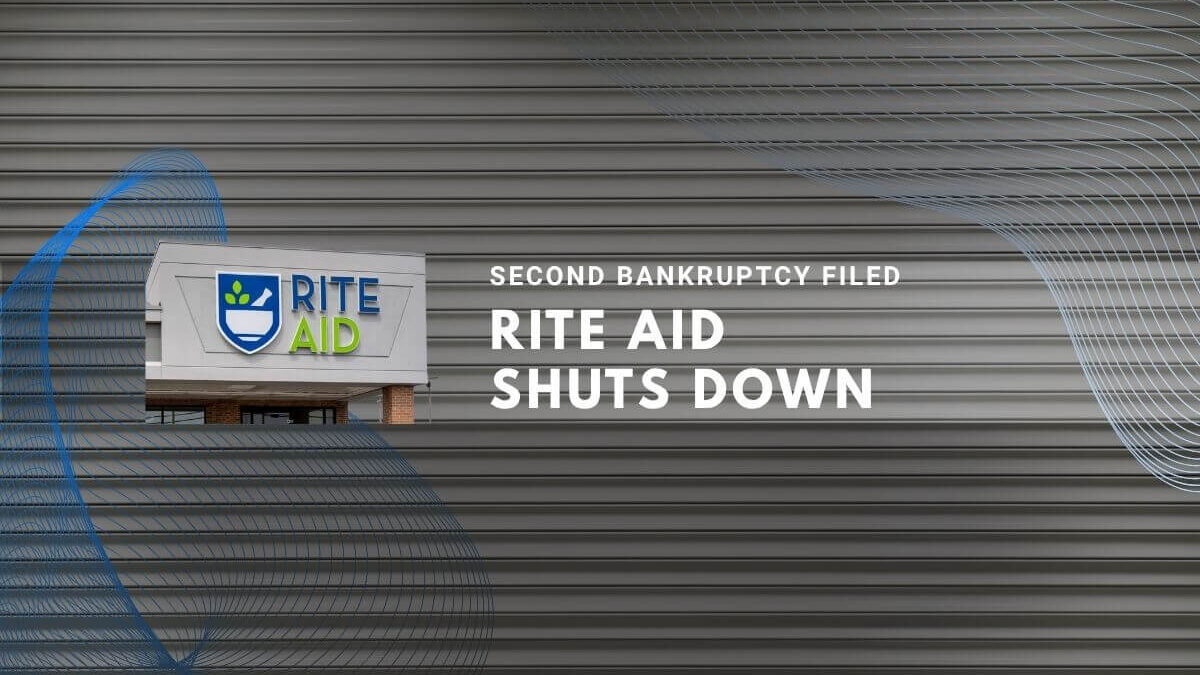Rite Aid closes all 1,240 pharmacy stores across the United States on October 5, 2025, following the company’s second bankruptcy filing in less than two years. The closures mark the end of a 63-year retail presence and leave customers across 15 states scrambling to transfer prescriptions to competing pharmacy chains. Aid closes all remaining locations as the pharmacy chain exits the market, directing customers to transfer prescriptions to CVS, Walgreens, and other regional pharmacies.
Second Bankruptcy Filing Leads to Complete Shutdown
Rite Aid filed for Chapter 11 bankruptcy protection in May 2025, just eight months after emerging from its first bankruptcy in September 2024. The company cited total liabilities exceeding $2.5 billion at the time of filing. Court documents show Rite Aid secured $1.94 billion in new financing from existing lenders, but ultimately decided to liquidate all remaining assets rather than continue operations.[1][2]
The pharmacy chain operated approximately 1,275 stores and three distribution centers when it filed for bankruptcy in May 2025. By early October, fewer than 100 locations remained open before final closure on October 5.[3][4]
Opioid Litigation and Legal Settlements
Rite Aid faced more than 1,000 federal, state, and local lawsuits alleging improper prescription practices for opioids. The Justice Department filed a civil complaint in March 2023 accusing the company of violating the False Claims Act and Controlled Substances Act by unlawfully filling prescriptions for oxycodone, fentanyl, and benzodiazepines.[5][6]
Opioid litigation settlements reached approximately $30 million by 2025. The company reached a settlement with the Justice Department in July 2024 addressing these violations.[4][7]
Prescription Transfer Process for Customers
Rite Aid directed affected customers to its official website to access prescription and immunization records. Most prescription files were transferred to CVS, Walgreens, and other regional pharmacy chains as part of court-approved asset sales.[8][9]
Customers can trace where specific prescriptions were transferred through the company’s online closure and transfer list. The website allows former customers to request complete pharmacy histories for their records.[8]
Steps for Former Rite Aid Customers
- Visit the Rite Aid website to request prescription and immunization history
- Check the pharmacy closure list to identify receiving pharmacies
- Contact the new pharmacy location to confirm prescription transfer completion
- Verify medication refill schedules and insurance coverage at the new location
Asset Sales and Brand Liquidation
Rite Aid sold its iconic Thrifty Ice Cream brand to Hilrod Holdings for $19.2 million as part of bankruptcy proceedings. Hilrod Holdings is owned by Monster Energy CEO Hilton Schlosberg and former co-CEO Rodney Sacks. The sale was approved by a federal bankruptcy judge in early July 2025.[10][11]
CVS, Walgreens, and other chains acquired approximately 1,000 Rite Aid store locations since the May bankruptcy filing. Additional buyers included Albertsons, Kroger, and Giant Eagle. Dollar Tree acquired some unexpired leases for future expansion.[3][12]
Industry Consolidation and Market Impact
Rite Aid’s complete closure reflects broader consolidation trends in U.S. pharmacy retail. CVS has closed more than 1,000 locations since 2021 as part of strategic restructuring efforts. Walgreens, recently acquired by private equity firm Sycamore Partners, shuttered approximately 500 stores in the past year.[4][13]
Industry analysts warn that widespread pharmacy closures create significant healthcare access gaps in underserved communities. Independent pharmacies are expected to absorb displaced Rite Aid customers, though capacity constraints may limit availability in rural areas.[3][14]
Changing Pharmacy Business Models
Major pharmacy chains are shifting focus from traditional retail operations to integrated healthcare services. CVS, Walgreens, and competitors are investing in telehealth platforms, prescription home delivery programs, and in-store health clinics. These models aim to reduce real estate costs while maintaining customer access to pharmacy services.[4][13]
Read More: Rite Aid pharmacy chain closes its last remaining stores
Community Healthcare Access Concerns
The elimination of 1,240 Rite Aid locations has left considerable gaps in community pharmacy access. Cities such as Buffalo, New York, and other regions with limited pharmacy alternatives face particular challenges as residents lose convenient access to prescription medications and immunization services.[14][15]
Customers in 15 states who relied on Rite Aid as their primary pharmacy must now identify alternative providers. Many face longer travel distances or unfamiliar pharmacy systems as they transition prescriptions and medication histories.[2][4]
